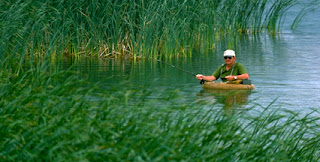Understanding the Fundamentals of Trolling for Saltwater Fish While on Fishing Vacations in Texas
Whether close to shore or
offshore, trolling is usually considered to be the most fruitful techniques on fishing
vacations in Texas to catch a wide
assortment of saltwater fish. From the blue water pelagics to the close-in
bottom fish, trolling is generally the key to making many good catches.
Still several anglers avoid
making use of this technique either because anglers have had very little
success previously or because they just never understood and mastered the basic
techniques.
For an average angler, trolling is
broken down into an amalgamation of four easy categories such as fast or slow,
shallow or deep. It actually can be that easy if you understand the habits of
the fish you are chasing.
Take a Look at the
Fundamentals of Trolling for Saltwater Fish While on Fishing Vacations in
Texas:
- The Terminal Gear: Having a wire leader is very important in the trolling world. The wire protects pelagics from cutting your fishing line from their mouth or sturdy tail kicks. 5 to 6 feet of wire leader from the hook must be connected to 10 feet of double fishing line. Make use of a Bimini twist knot for your double fishing line and tie it to a powerful Sampo snap swivel. Snap swivels enables a fast alteration-out of leaders. Usually, a good fish will set a bend in the wire and the snap swivel lets you to set another pre-rigged leader on without stopping. The hook size must match the bait and small hooks on big baits or hooks on small baits just do not work and can spoil your fishing vacations in Texas. Carrying numerous pre-rigged leaders through hooks from 5/0 to 9/0 is suggested- you might be trolling ballyhoo by making use of an 8/0 hook and then you find yourself right in the middle of a drill of smaller fish. That is when you move to a leader by a 5/0 hook, enabling additional hookups on these smaller mouths.
- Slow Trolling: Trolling shallow and slow generally means a live bait of some sort. Be it ballyhoo or goggle-eye, live bait must be able to swim a bit, which means trolling as slowly as your engine lets you, repeatedly moving just enough to keep the fishing bait at the back of the boat. Live fishing baits can be easily trolled on a free line at the back of the boat or on a downrigger. The similar leader set up is needed, but if the law allows, a treble hook on the 6 inches of wire leader is connected to and hanging from the main hook. This stinger hook is usually the hook which catches the fish, as the live baits have a tendency to kick out of the way of the predator’s attack. That treble catches many fishes! For boats whose engines gets inoperative quicker than the preferred trolling speed, drift bags attached to the stern can slow the boat spectacularly. But, when a fish is hooked ensure to drag the bag(s) into the boat for avoiding the tangled lines and vanished fishes.
- Deep Trolling: Trolling perfectly below the surface could be achieved in many ways. Few artificial lures are tailored to dig down and run deep often as deep as 30 feet unaided through weights. Wire line with dedicated fishing tackle, can take fishing baits downward in the water column. Possibly the simplest and most widespread technique of getting the fishing bait down is a downrigger. Wire line requires a rod tailored to deal with wire line and actually cannot be considered an easy trolling method. Right use of leaders, the trolling weights and shock leaders create this kind of trolling even more tough compared to the other methods. Besides the deep running fishing lures, the downrigger is the simplest approach to get fishing bait down deep. Just like a kite rig acts like an outrigger in the sky and the downrigger plays to be an outrigger below the water. The similarity refers to the reality that the fishing line is clipped to the downrigger and the fishing line is released as a fish strikes. Rigged natural baits must run true, which means that they must not spin beneath the water while trolled. Spinning is not natural and will really put off a fish from striking. Therefore, paying specific attention to your fishing bait and the hook position can make huge difference between fish and no fish on your Texas fishing vacations.
- Shallow Trolling: The shallow trolling technique refers to the fishing bait, not the deepness of water. In the blue water, the water is going to be several hundred feet deep, while your fishing bait will be on the surface. This trolling technique is utilized by the anglers and charter boats looking primarily for billfish, wahoo etc. All of these fish species feed on baitfish, which stays on the surface.
Trolling can be as difficult or
as simple as anglers want to make it. Keeping in mind the basics and keeping the
process simple will lead to success. Trolling covers more fishing area in a small
span of time compared to any other technique. It also usually means bigger
fish, so get ready accordingly!
Put a few fishing lines out, arrange a course and
sit back and relax and leave the rest to the fish chasing your fishing baits on
your next fishing
vacations in Texas.





Comments
Post a Comment